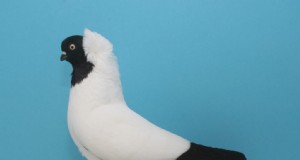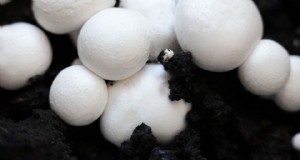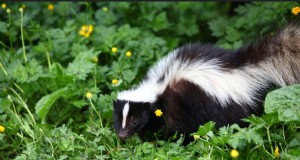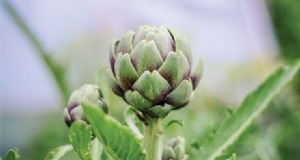UMA eu r - B reathing f é h c ultu ré
O peixe-gato e o peixe-gato são conhecidos pela sua estima e boa procura no mercado devido ao seu baixo teor de gordura e poucos espinhos intramusculares. Os peixes que respiram o ar são resistentes e capazes de respirar o ar atmosférico com seus órgãos respiratórios acessórios. Devido à presença desses órgãos respiratórios acessórios, esses peixes podem sobreviver por algumas horas fora da água. Esses órgãos respiratórios acessórios são árvores respiratórias em Clarias , órgão labiríntico em Channa , bexiga de ar em Heteropneustes , câmara branquial nos peixes acima, etc. e são capazes de engolir ar. Estes podem ser cultivados em áreas de baixo oxigênio dissolvido, como águas rasas e sujas, lagos e pântanos abandonados. Devido à sua capacidade de viver fora da água, sua cultura envolve baixo risco e gerenciamento simples.
Na Índia, Andhra Pradesh, Assam, Uttar Pradesh, Madhya Pradesh, Tamilnadu, Karnataka, Maharastra, Bihar e Meghalaya suportam a pesca natural mais significativa de peixes que respiram o ar. Esses peixes são carnívoros por natureza e se adaptam de maneira excelente à alimentação complementar. Como não há muito desperdício de energia através da respiração pelos respiradores de ar crescentes de águas rasas, bons rendimentos podem ser esperados.
As espécies cultiváveis de peixes que respiram ar são Fig. 9.1
C h uma nn uma s t r uma isto você s - Peixe grande ou listrado ou com cabeça de cobra
C hann uma punctatu s - murrel manchado
Channa marulius - Murrel gigante
Clarias batrachus - Magur
Heteropneustes fossilis - Singhi
Anabas testudineus - Koi ou poleiro escalador.
Fora destes Channa estriado tem a maior demanda nos mercados e também comanda um preço mais alto. Os próximos melhores são Clarias e Heteropneustes . A cultura das espécies acima é lucrativa.
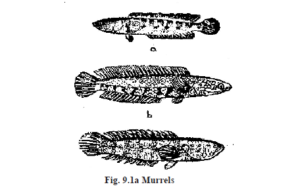
a) Channa marulius b) Channa straitus c) Channa punctatus
Cu eu turab eu e área s
A cultura de peixes que respiram ar necessita de águas rasas com uma profundidade de 50 - 75 cm. Lagoas para a cultura de peixes que respiram ar não precisam ser fertilizadas por produtos químicos. Peixes que respiram ar também podem ser cultivados em gaiolas em sistemas de água corrente, como riachos, canais e águas incontroláveis como reservatórios. A cultura de peixes que respiram ar é igualmente adaptável em águas inadequadas para espécies convencionais de carpas cultiváveis, bem como em tanques de cultura de carpas. Lagoas rasas são úteis para peixes, em que o peixe tem que gastar menos energia para viajar para a superfície para a ingestão de oxigênio atmosférico.
Ver d coleção n
A semente de murrel, magur e singhi são coletados dos recursos naturais, apesar do sucesso alcançado na reprodução induzida. Ainda hoje, as sementes coletadas na natureza continuam a ser a fonte mais confiável de material para estocagem. Murrels atingem a maturidade em dois anos e se reproduzem durante todo o ano. Os alevinos de 2-4 cm podem ser coletados durante todo o ano e em valas de sequeiro e corpos d'água rasos com ervas daninhas abundantes. No entanto, sabe-se que o pico de desova ocorre pouco antes das monções.
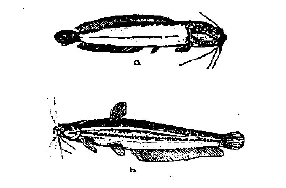
a) Clarias batrachus b) Heteropneustes fossilis
Os jovens que emergem dos ovos movem-se em cardumes e a sua recolha em grande número é sempre fácil. Os alevinos podem não tender a se mover em cardumes. Os filhotes do murrel gigante podem ser identificados por seu corpo cinza escuro e uma faixa amarelo laranja lateral do olho à nadadeira caudal. Os filhotes de murrel despojado têm corpo vermelho vivo com faixa dourada avermelhada e uma faixa preta escura do olho até a nadadeira caudal. Os alevinos malhados podem ser reconhecidos pelo seu corpo castanho-escuro com uma banda lateral amarelo-ouro e uma linha amarela dorsal média no dorso.
Na cultura murrel, é melhor estocar alevinos do que alevinos. O canibalismo é encontrado em alevinos. A taxa de sobrevivência dos alevinos que é produzida pela reprodução induzida é baixa e é difícil manter a desova e fazê-los crescer até o estágio de alevinos. As crias não comem nada por dois dias após sua emergência dos ovos. Portanto, os alevinos devem ser treinados para aceitar alimentos suplementares em tanques separados. O alimento complementar consiste em ovos cozidos, pupas de bicho-da-seda, peixe de lixo picado e minhocas junto com fermento e vitamina B.
É administrado durante cerca de 15 dias a uma taxa de 20% do peso corporal total. Os alevinos atingem a fase de alevinagem de 4-6 cm de comprimento em um mês.
Os peixes-gato se reproduzem duas vezes por ano, com o pico da estação reprodutiva durante a estação chuvosa. Os alevinos de Magur podem ser identificados pela barbatana dorsal mais longa e pela cor ardósia. Os alevinos de Singhi têm barbatana dorsal curta e coloração rosa. Os alevinos de Koi podem ser identificados pela mancha escura no pedúnculo caudal e tonalidade esverdeada na superfície dorsal do corpo. Os magurs fazem um buraco de 25 cm de profundidade no cômoro abaixo da superfície da água. Os ovos fertilizados aderem à grama e são guardados pelos machos. 2, 000 - 15, Podem ser recolhidos 000 alevinos de cada cova com a ajuda de pequenas redes manuais de malha fina e criados em viveiros até atingirem a fase de alevinagem com cerca de 5 cm de comprimento.
Magur pode ser cultivado em tanques para a produção de alevinos. Compartimentos de 1 x 1 m de tela de arame são feitos nas margens do cômoro. No centro de cada compartimento, um buraco de 30 cm de diâmetro é cavado e tem poucas plantas aquáticas. Depois de liberar ambos os sexos, por volta de 5, 000 alevinos podem ser coletados de cada compartimento dentro de 10 dias. Os machos e as fêmeas também podem ser criados em pequenos lagos terrestres. Eles podem ser estocados em 20, 000 / tanque e alimentados com zooplâncton filtrado ou farinha de peixe picada e torta de óleo de amendoim. Os alevinos podem ser criados por 15 dias em viveiros.
A estação alta para a coleta de sementes de singhi é o período pré-inverno, quando o arroz é colhido e os campos baixos ficam expostos.
Ver d tr uma nspor t
Os alevinos ou alevinos de peixes que respiram ar podem ser transportados sem embalagem de oxigênio. Tambores de polietileno ou tambores de ferro são usados para o transporte de alevinos ou alevinos. O transportador deve ter espaço suficiente para sua superfície habitual para respirar o ar atmosférico. O transportador deve ter uma pequena quantidade de ervas daninhas aquáticas como Vallisneria, Hydrilla , Myriophyllum e Ceratophyllum . As ervas daninhas podem ajudar a evitar que os peixes saltem durante o transporte. Se a distancia for maior, é melhor transportá-los em recipientes de polietileno embalados com oxigênio.
Pon d mãe n ageme n t
Os viveiros têm cerca de 10 a 15 m2, tendo uma coluna de água de 50 cm. Estes são estocados com 0,2 - 1,5 milhões de alevinos / ha. Antes de estocar, a adubação é feita apenas com esterco de gado cru, na proporção de 500 Kg / ha. A emulsão de óleo de sabão para erradicar os insetos é aplicada na água do viveiro. Os alevinos e alevinos de magur e singhi coletados de recursos naturais requerem manejo de viveiro, mas os murrels devem ser treinados em tanques-viveiro antes de serem estocados. Após o manejo do viveiro, os alevinos devem ser transferidos para tanques de estocagem.
Stoc k no g
Alevinos de tamanho uniforme são escolhidos para estocagem. Os alevinos são desinfetados com solução de KMNO4 2% por 5 minutos ou mergulhados em solução de formalina 200 ppm por 50 segundos antes da meia. Alevinos feridos são tratados com acriflavina 0,3% por 5 minutos.
Esses peixes podem escapar escalando ou cavando. Portanto, os cômoros da lagoa devem ser firmes com toras pesadas ou madeira, ou cercado com cana de bambu ou telas de arame até uma altura de cerca de 50 cm.
Mais alevinos podem ser estocados em seu sistema de cultura. 40, 000-60, 000 sistemas.
alevinos / ha de peixes-gato podem ser armazenados em monocultura. Em sistemas de policultura 20, 000 - 30, 000 alevinos / ha de gato
peixes podem ser estocados. Em sistemas de monocultura, 15, 000 alevinos / ha de mexilhões gigantes, 20, 000 / ha no caso de murrel listrado e 20, 000 - 30, 000 / ha no caso de murrelare manchado estocado. Em sistemas de policultura, murrel listrado e manchado pode ser estocado a uma taxa de 20, 000 alevinos / ha na proporção de 1:1.
A policultura de mexilhões - carpas e bagres - carpas também é possível com cuidado e manejo adequados. As sementes de peixes que respiram ar devem ser estocadas apenas quando as carpas tiverem crescido a um mínimo de 300 gr, para que os peixes que respiram o ar não possam atacar as carpas. Com isso, não apenas uma renda adicional pode ser obtida através da produção de peixes que respiram ar, mas também o crescimento de carpas pode ser aumentado. O mais tarde é possível, como peixes de lixo que podem competir com carpas por comida e espaço, são erradicados pelos crescentes respiradores de ar.
Feedin g
Para manter um suprimento abundante de alimentos para respiradores de ar em crescimento, o tanque de armazenamento deve ser rico em fonte de alimento animal, como girinos de rã e peixes-lixo. Se esta fonte de alimento não for suficiente, a tilápia também pode ser cultivada em viveiros de peixes-gato e murrel. Peixe seco do lixo marinho também é usado na piscicultura e é mais econômico. A alimentação pode ser dada a bagres com miudezas de peixes ou resíduos de matadouro ou pupas de bicho-da-seda secas misturadas com farelo de arroz e bolo de óleo na proporção de 1:1:1:1. Uma mistura de bolo de óleo, farelo de arroz e pasta de biogás na proporção de 1:1:1 proporcionou uma alimentação de baixo custo bem-sucedida para singhi. Farelo de arroz e ração para aves em 3:1 e biogás e farelo de arroz em 1:2 também podem ser administrados na proporção de 5 a 8% do peso corporal.
Durante os oito meses de cultura semi-intensiva em lagoas estagnadas, o estoque de bagres que respiram ar pode ser alimentado na seguinte taxa diariamente durante as horas escuras do dia para obter melhor utilização da ração (Tabela 9.1).
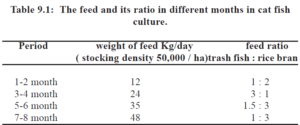
A ração pode ser transmitida no tanque em pequenas quantidades a partir do cômoro ou pode ser servida em cestos de ração baixados perto da margem, além da transmissão de ração para garantir a disponibilidade de ração para todos os peixes no tanque. Armadilhas leves podem ser instaladas em tanques de molusco, pelo qual os insetos podem ser atraídos pela luz e utilizados por murrels como um alimento rico em proteínas.
Os alevinos de murrel treinados também aceitam peixes de lixo marinho secos de maneira barata embebidos em água, que pode ser fornecido de acordo com o seguinte esquema de alimentação (Tabela 9.2). Resíduos de matadouros e pupas de bicho-da-seda como fonte de proteína animal também podem ser usados.
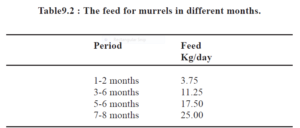
Gr o wt h uma n d p r od você ct eu o n
Murrels e peixes-gato atingem tamanhos comercializáveis em um período de meses, respectivamente. Se as práticas de gestão forem adequadas, murrels gigantes e listrados podem atingir um crescimento de 1 - 2 Kg / ano. e 0,75 kg / ano. respectivamente, enquanto os murrels pintados crescem até 160 gr. em 8 meses. Peixes-gato são conhecidos por crescerem lentamente quando comparados aos moluscos. Magur e singhi crescem até 0,2 kg e 0,1 kg, respectivamente. A taxa de conversão com feed recomendado é de aproximadamente 2:1.
Murrels com peixes forrageiros como alimento suplementar produzem cerca de 4 toneladas / ha / ano. Magur com peixe seco e ração suplementar com farelo de arroz, dar a produção de 10 toneladas / ha / ano. Singhi dá um rendimento de 4,4 / t / ha / ano. Policultura de murrel e koi, alimentado com farelo de arroz, bolo de óleo de mostarda e peixe lixo, dar uma produção de 11,8 toneladas / ha / ano, enquanto o magsur e o singhi alimentados com farelo de arroz e peixe lixo produzem uma produção de 5 toneladas / ha / ano. A cultura mista de 3 espécies de murrels produz 4 toneladas / ha / ano quando alimentada com peixes de lixo marinho ensopados e secos e pupas de bicho-da-seda frescas como alimento. Na cultura intensiva o magur pode dar 7 toneladas / ha / 5 meses.
C ul t vc e C eu t h ca r p s
Com uma densidade de estocagem de 5.000 / ha de carpas indianas e chinesas e 1.000 alevinos de magur produzem 2.518 Kg / ha / ano de carpas e 3.711 Kg / ha / ano de magur. Isso indica que a policultura é mais lucrativa, e é útil incluir magur no sistema de cultivo da carpa. Com densidade de estoque de 20, 000 / ha de magur junto com as sobras de carpas (após a colheita parcial das carpas), uma produção de 3,96 toneladas / ha / ano é obtida com uma proporção de farelo de arroz de 50:30:17:3, farinha de peixe, torta de óleo de amendoim e minerais como suplemento alimentar. O magur é considerado adequado para a cultura de peixes compostos de carpas no lugar da carpa comum. Magur, koi e singhi também são adequados para a cultura, juntamente com uma carpa makhana de alto preço, Euryale ferox .
Har v Estin g
A temporada de verão é ideal para a coleta de peixes que respiram ar em lagoas. O tanque é drenado e os peixes são apanhados com o auxílio de redes ou redes manuais. Devido à alta demanda e preço de mercado, a cultura desses respiradores proporciona uma renda lucrativa aos piscicultores com técnicas de manejo simples.
C uma g e culto você r e
Os respiradores de ar também podem ser cultivados em gaiolas. As gaiolas são preparadas com esteiras de bambu fendido em águas correntes. A área ideal da gaiola mede 2m X 1m X 1m de tamanho. O topo da gaiola é coberto pela metade com esteira e a parte descoberta coberta com uma rede para facilitar a alimentação e evitar a fuga dos peixes. A malha de fibra sintética também é usada para preparar gaiolas.
Magur são estocados a uma taxa de 200 / gaiola, alimentado com 10% do peso corporal em peixes secos, bolo de óleo e farelo de arroz e produzir 10 - 12 Kg / m³ / ano. Singhi produz 12-20 Kg / cu.m. / ano com densidade de 100-150 / gaiola e 10% do peso corporal para alimentação de pupas de bicho-da-seda, farelo de arroz e bolo de óleo de mostarda. As carpas produzem 4,2 Kg / m3 / ano com uma taxa de lotação de 50 - 100 / gaiola com o mesmo alimento que o singhi. O murrel manchado produz 4 Kg / m3 / ano com peixe lixo e farelo de arroz. Portanto, a cultura de peixes que respiram ar é altamente lucrativa, bem como uma rica fonte de proteína animal. Este peixe é considerado um delecacy, e comanda um preço muito alto e demanda contínua nos mercados.
T R OU T CU eu T UR E
A truta é cultivada como alimento para peixes ou peixes esportivos, são lançados em águas naturais para os pescadores esportivos. A truta é popular porque é atraente, peixe de combate ativo e fornece carne de altíssima qualidade. As trutas foram soltas e cultivadas na água em todo o mundo. As trutas são cultivadas em escala comercial nos EUA há muito tempo. Sua cultura na Europa remonta a 400 anos. É um peixe de água fria. Habita principalmente rios, córregos, riachos, lagos e lagoas. Na Índia, é encontrado na Caxemira, Himachal Pradesh, Uttar Pradesh, Nilgiris, Colinas Kodai e cordilheira de Munnar.
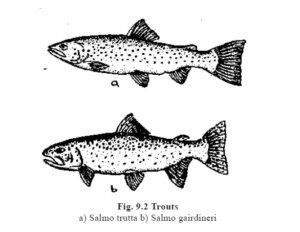
Muitas espécies de trutas são cultivadas, mas os três mais comuns deles são a truta arco-íris, Slamo Gairdneri ou Oncorynchus meu beijo, a truta marrom europeia, S.trutta (Fig. 9.2) e a truta de riacho, Salvelinus fontinalis. As trutas têm um corpo aerodinâmico, aberturas de brânquias estreitas e brânquias reduzidas. As trutas são adaptadas a águas altamente oxigenadas e temperaturas de ponto de congelamento. As trutas têm grande poder de locomoção com hábitos de agarramento e escavação. A boca é modificada com lábios ásperos para coleta de alimentos de seixos, rochas, etc ..
S p aw n no g
A época de desova de S.gairdneri é de setembro a fevereiro, S.trutta é de outubro a dezembro e S.fontinalis é de outubro a janeiro. As trutas preferem substrato de cascalho para proteger seus ovos e os ovos grudam em cascalho e detritos. As trutas constroem ninhos e desovam nos leitos dos rios. Os cultivadores permitem a fertilização artificial, porque a fertilização do leito do rio resulta em menor taxa de eclosão do que a fertilização artificial. A manipulação do fotoperíodo e da temperatura da água pode ser usada para induzir a maturação gonadial, para que os peixes jovens sejam gerados ao longo do ano. As trutas são apanhadas na maturidade ou perto da maturidade, à medida que nadam contra a corrente e são criadas até à maturidade nos tanques. Os peixes crias são colocados em pequenos tanques com água corrente e frequentemente cobertos com rede para evitar que saltem. O milt de um único macho pode ser usado para fertilizar duas fêmeas, de modo que mais fêmeas são abastecidas com poucos machos.
As trutas apresentam dimorfismo sexual. Os machos tornam-se mais coloridos e a mandíbula inferior desenvolve um bico em forma de gancho durante a época de reprodução. As mulheres desenvolvem barrigas alargadas e a papila genital torna-se maior e avermelhada. Quando estão totalmente maduros, Milt ou ovos saem com pouca pressão na ventilação abdominal. Quando a truta está madura, as fêmeas são retiradas e os ovos coletados em um esmalte preto ou recipiente de plástico ao qual o milt do macho é adicionado e misturado completamente com uma pena de pena para fertilização. A água é adicionada após a mistura e a água faz com que os ovos inchem. A água não deve ser adicionada antes da mistura, uma vez que a motilidade dos espermatozoides é bastante reduzida na presença de água. Para garantir uma melhor taxa de sobrevivência, os ovos podem ser coletados em uma pequena quantidade de solução salina (10 litros de água doce +90 gr. sal comum + 2 gr. cloreto de potássio + 3 gr. cloreto de cálcio). Os ovos fertilizados desenvolvem uma coloração verde e são conhecidos como ‘verdes’, que são então transferidos para incubatórios. Antes de transferir, remova as partículas estranhas e os ovos mortos.
T ra ns p o r t no eu o n o f t derrota e gg s
Os ovos fertilizados e endurecidos (endurecidos por 24 horas) de truta são transportados em caixas de papelão de tamanho 20 X 30 X 20 cm. O lado interno da caixa de papelão é forrado com um forro de isopor. Duas esponjas úmidas ou almofadas de algodão são dispostas, um na parte inferior e outro na parte superior. Sacos de polietileno poroso contendo cerca de 4, 000 ovos são colocados entre as esponjas úmidas e as almofadas de algodão. Um saco de polietileno com IKg de gelo quebrado é mantido para manter a temperatura baixa, acima da almofada superior. Essas caixas de papelão são transportadas para vários lugares.
Hatcher y tec h nique s
Os ovos de truta são incubados mantendo-os em cochos de concreto com bandejas planas e dispostas horizontalmente, incubadoras ou jarras. Os incubatórios devem receber água doce filtrada e livre de sedimentos. Antigamente, cestos eram usados para incubação. As incubadoras de fluxo vertical são as mais comuns. Tem muitos aço inoxidável, de fibra de vidro, alumínio, ou madeira, ou PVC, ou bandejas de plástico, dispostos um acima do outro. A parte inferior das bandejas é fornecida com folhas de zinco perfuradas, grelhas de vidro ou tela de malha para garantir a passagem da água pelos diferentes tabuleiros. O tamanho pode variar de 180 x 30 x 10 cm a 500 x 100 x 50 cm. Cada bandeja possui uma cesta superior para ovos e um compartimento inferior perfurado no qual a cesta é apoiada. Os ovos são colocados na cesta para incubação. A água é introduzida na bandeja de forma que escorra pela cesta que contém os ovos, em seguida, desça para a bandeja abaixo e suba pela cesta e assim por diante, pela incubadora. Este fluxo ascendente de água através dos ovos permite maior aeração e facilita a remoção de metabólitos.
Os potes de incubação também são usados para a incubação de ovos de truta. Consiste em uma tela galvanizada de malha de 0,5 mm com leito de cascalho na parte inferior, logo acima da entrada. Este leito de cascalho é útil como filtro para remover as partículas indesejadas. Os ovos são colocados acima do filtro para incubação. A água passou pela entrada, sobe através do filtro e dos ovos e drena pela saída. Após a incubação, os filhotes são mantidos por algum tempo nos potes.
Os ovos são altamente sensíveis durante o período de incubação. Ovos recém-fertilizados podem ser mortos se expostos diretamente à luz solar. Durante a incubação, a água deve estar em movimento e ter um alto teor de oxigênio. A incubação normalmente ocorre em água com temperatura de 8 ° -12 ° C. Os alevinos podem ser mantidos nas bandejas até que se tornem ativos e possam começar a mamar. Podem ser liberados para estocagem em águas naturais.
Cu eu tu ré o f t rou t s
Os alevinos são criados em pequenos cochos de criação antes de terem absorvido completamente o saco vitelino, e apresentar para viver com alimentos artificiais. Em seguida, eles são transferidos para viveiros de viveiro para a criação até o estágio avançado de alevinagem. Os tanques-viveiro podem ser de concreto ou paredes de pedra com tamanhos de 2,5 X 1 X 0,75 m a 9 X 1 X 0,75 m. O fluxo de água pode ser mantido 100 litros / min. dentro do viveiro.
Os alevinos avançados são criados para adultos em tanques de criação e pistas. O lago de criação é um corpo de água natural, e uma pista de corrida é apenas um tanque de peixes de água corrente. O tamanho das pistas deve variar de 20 a 100 m2 com profundidade de 1,5 m. Uma série de canais adutores são construídos em ambos os lados do riacho ou rio. Cada canaleta recebe água do riacho e a água sai da canaleta pela saída que se encontra no lado oposto. As telas de placa de zinco são usadas nas entradas e saídas. O fluxo de água é mantido 50 litros / s, nas lagoas do rio. Lagoas circulares e ovais são usadas nos EUA. A taxa de lotação pode ser limitada a produzir 5-10 Kg / m2. Alta produção de 200 Kg / mis também é possível em pistas, se a gestão é boa.
A cultura da truta em gaiolas também é comum. Em um experimento, os alevinos foram estocados a 1,4 Kg / m2 em gaiolas e alimentados com 3 % de seu peso corporal diariamente. Essas trutas cresceram para 27-88 gr. em dois meses. A alimentação dada às trutas inclui baço de gado, coração e pulmão e peixes de lixo marinho ou de água doce. Muitos alimentos comerciais para trutas estão disponíveis no mercado. A truta é alimentada de 3 a 4 vezes ao dia. Existem várias maneiras de alimentar trutas. A ração é borrifada na superfície da água, ou a ração pode ser mantida em um saco ou em um recipiente no canto do tanque. É usado para os alimentadores de demanda, em que sempre que uma truta bate no gatilho, o alimento é lançado na água, ou alimentadores automáticos também podem ser usados. Os potes e tambores também são usados para criar alevinos de truta.
Se C ag e - Fe d F eu s h Cu eu tu ré
O esgoto está turvo, fluido sujo e odorífero de nossos banheiros e cozinhas de nossas casas. Possui minerais e nutrientes orgânicos no estado dissolvido ou dispersos no estado sólido. O descarte de esgoto se tornou um problema global por causa da urbanização. É um efeito da demóforo, ou seja, um crescimento ininterrupto da população humana. Nos últimos anos, o esgoto tornou-se um grande poluente das águas interiores, especialmente rios. É fonte de muitas epidemias. É responsável por uma séria ameaça aos ecossistemas de solo e água. A abordagem para o descarte de águas residuais deve ser o aproveitamento desse resíduo com o conceito de seu reaproveitamento ou reciclagem por meio de um sistema ecologicamente equilibrado envolvendo principalmente a aquicultura. A utilidade do efluente de esgoto para aumentar a fertilidade de tanques de água doce é há muito conhecida em muitos países do mundo.
A quantidade de esgoto produzido é a Índia em 3,6 mm3 / d (milhões de metros cúbicos por dia) ou 800 mg / d (milhões de galões por dia). Cerca de 30% (1,9 mm3 / d) é produzido nos centros urbanos. Apenas 1,3 mm3 / d (20,4% do total da Índia em um dia) é tratado nesses centros. Quase 80% do total de um dia do país ainda precisa ser tratado e utilizado. A quantidade de estrume obtida da produção de esgoto de um dia na Índia é de cerca de 0,126 m.toneladas. Isso é igual a 46 m.toneladas / ano. O esterco do esgoto de um dia é suficiente para cultivar 0,1 m.hectare de safra anual de peixes. O esgoto também é útil para o cultivo de peixes. Na Índia, apenas 130 outras fazendas de peixes alimentadas com esgoto são encontradas cobrindo uma área de 12, 000 hectares. A pesca com esgoto de Vidyadhari perto de Calcutá é um exemplo, onde os pescadores têm aproveitado ao máximo os sistemas de esgoto de Calcutá. Aqui, a produção de peixes é de cerca de 1, 258 Kg / ha. A alta capacidade de manejo se alia à potencialidade de servir como fonte adicional de água para piscicultura e potencializar a produção pesqueira.
Co m posi t io n o f sewa g e
A composição do esgoto varia de local para local e de acordo com a estação do ano. A água é o principal componente do esgoto (99%) e a suspensão sólida no esgoto atinge apenas 1%. Em média, o esgoto das cidades indianas contém 52 ppm de nitrogênio, 16 ppm de fósforo, 45 ppm de potássio e 350 ppm de matéria orgânica biodegradável. O componente de carbono orgânico é 25-40 ppm, the ratio of carbon and nitrogen being 1:3. Salts of several heavy metals such as Zn, Ni, Cr, Pb, etc. are also found above the permissible levels in sewage. The organic refuses in the sewage have proteins, carbohydrates and fats in varied proportions depending on the nutritional status and food habits of the population. Among carbohydrates, readily degradable starch, sugar and cellulose are detected.
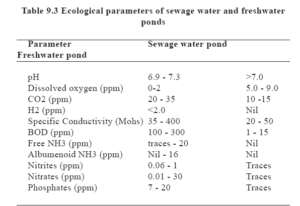
Some ecological features of different waters are mentioned in Table 9.3. Sewage water has high BOD (Biological Oxygen Demand) and Oxygen Consumption (OC) values. Dissolved oxygen becomes depleted in sewage water due to high oxygen demand and low photosynthetic rate. Photosynthesis is low because of poor illumination as the suspended solids in sewage water obstruct sunlight. Em média, Forte, medium and weak sewage consist of 1200 ppm, 720 ppm and 350 ppm of total solids respectively, out of which 850 ppm, 500 ppm and 250 ppm occurs in a dissolved state and 350 ppm, 220 ppm and 100 ppm is found in suspended form. Dissolved salts being very high in sewage water, manifest high specific conductivity. Production of acids in high amounts render the water acidic, making the medium unfit for supporting life (Fig. 9.3). Acidity of water below pH4 is known to kill the flora and fauna.
Sewage enriches water with organic matter that begins to decompose aerobically thereby depleting dissolved oxygen and leading to anoxic condition. Anoxia causes non-mortality of animals, adding organic matter further to the already rich organic content. In the absence of dissolved oxygen the organic matter undergoes anaerobic decomposition as a result of which obnoxious gasses like H2S, CH3 and CO are produced. These gasses besides being toxic, react with water to form acids.
Immediate effect of sewage on the biota is eutrophication. Sewage water stimulates rapid growth of phytoplankton leading to an algal bloom followed by rapid increase in zooplankton. For utilizing sewage in aquaculture, the properties such as the concentration of dissolved and suspended solids, organic carbon, nitrogen and BOD are essential.
Micro b iolog eu ca eu c harac t arist eu c s
Harmless and even useful non-pathogenic bacteria are present in much greater numbers in domestic sewage as compared to pathogenic bacteria comprising mostly the intestinal microorganisms found in the community producing the waste. Usual load of coliform bacteria in raw sewage ranges between 108 and 109 MPN/100ml.
Si t e s e lect eu o n uma n d c em primeiro lugar r ucti o n o f se C age- f e d fis h longe m
Fish farm in the vicinity of an urbanized area has the scope to receive domestic sewage for the recycling of nutrients. Any area adjacent to a municipal sewage treatment plant is ideal for the location of a sewage-fed fish farm. The fish farm site should be at a lower level than the treatment plant so that the sewage can easily enter into the pond through a pipeline by gravity. The fish farm should have facilities of draining out water from the ponds.
The plan of the fish farm depends upon the source of the sewage, system of culture and topography of the land. Nearly 75% of the total area is converted into ponds leaving the rest for dykes and other purposes. Rectangular fish ponds of 0.3 to 1 ha are constructed with a slope of 1:3 for the embankment and maximum depth of 1.5m. Each pond should have proper drainage facilities.
The effluent is collected in a sump at the farm, from where the effluent is taken into the ponds through the distributing system. Additional arrangement is made to connect the pipelines with freshwater supply for emergency dilution.
S e abanar e tr e atme n t
Sewage treatment is necessary to kill the harmful microbes, prevent anoxia, raise the pH to an alkaline level, increase photosynthesis, reduce organic content, etc. The treatment has to be inexpensive and one which induces in sewage water the conditions prevailing in a natural freshwater pond. Sewage is treated in following three ways – mechanical treatment, chemical treatment and biological treatment.
Mech uma nica eu t reatment:
Solids and organic matter are removed to a large extent by mechanical treatment, which involves flowing, dilution and sedimentation. Usually screening and straining of sewage it is done to remove the waste solids. The liquid and semisolid wastes are then
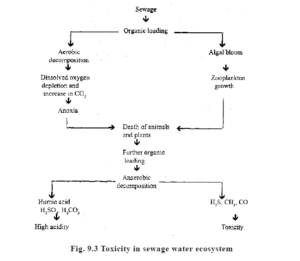
subjected to treatment for the removal of colloidal and semisolid suspension by dilution, H2S, CO2, CO, NH3, CH3 concentrations are brought below the normal levels. Assim, through primary treatment the supernatent effluent is separated from the sludge.
C h emic uma eu t reatment:
In chemical treatment, several dissolved substances, harmful germs and aggressive odours are eliminated. Inexpensive precipitants,
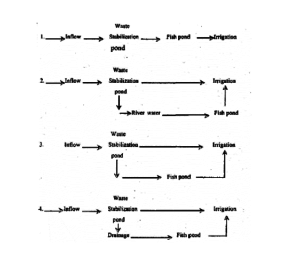
coagulants, chelating substances, disinfectants, deodorising agents, etc. are used in this treatment. The sewage water is also treated with chlorine, bleaching powder and copper sulphate. It is also known as secondary treatment.
Biol o gica eu t r e atment :
In biological treatment of sewage care is taken to promote bacterial growth. Bacterial action promotes oxidation of organic matter. The end products nitrogen oxides, bring about rapid growth of algae, particularly the blue green Microcystis. This arrests anoxia of water by raising the dissolved oxygen, lowering the CO2 content and by increasing the pH from acidic to alkaline levels. The algal bloom reduces the concentration of dissolved salts in the sewage water.
Po n d Mãe n ag e homens t
F e rtil eu zati o n
Fertilization of sewage-fed pond is done in two phases, pre-stocking and post-stocking fertilization. In dewatered and sun dried ponds, primary treated sewage effluent is taken up to a depth of 60 – 90 cm during premonsoon months (April – May). The effluent is then diluted with rain water or freshwater till the pond BOD reduces to 50 ppm. Periodic fertilization with sewage effluent is carried out after two months of stocking to maintain nutrient status and productivity of the pond at a desired level. The quantity of sewage effluent to be allowed into a pond solely depends on its quality determined on the basis of BOD values.
Limin g
Application of lime in sewage-fed ponds is most essential. It is a useful promotor of fertility in ponds and act as a disinfectant against harmful microorganisms. Prestocking liming is recommended at a rate of 200 – 400 Kg/ha as initial dosage. Subsequent liming of 150 – 200 Kg/ha on standing crop is necessary throughout the year during sewage intake and during winter months, when parasitic infection is more.
Stoc k no g
The cultivable species of freshwater fish such as Indian major carps and exotic carps can be grown in sewage-fed waters. Considering the high carrying capacity and high productivity of sewage-fed ponds with respect to plankton and benthic fish food concentration, fish are usually stocked at a reasonably higher density. The stocking rate recommended 10, 000 – 15, 000 /ha of carp fingerlings of about 10 gr. each and it is preferred to stock more of omnivorous scavengers and bottom feeders to maintain fish pond hygiene for higher yield. The ratio of carps for better output is rohu 2.5 :catla 1:mrigal 2.5 :common carp 2 :silver carp 2. Omnivores and bottom feeders directly consume the organic detritus of sewage-fed ponds, and thereby directly helping in keeping the pond aerobic. The stocking rate of fish is kept on a higher side considering the profuse growth of algae which will otherwise grow, decay, putrify and finally deplete the oxygen concentration of fish pond.
E c ologica eu c onsideratio n s um d uma lga eu cont r o eu
Maintenance of aerobic conditions of the sewage-fed pond is highly essential and as such early morning dissolved oxygen level should not deplete below 2 ppm for carps. The BOD should be below 30 ppm for better survival of fishes. CO2 concentration should not be allowed to increase beyond 20 ppm to keep the toxicity level within tolerance limit for fish and to control algal blooms. Liming helps in regulating CO2. Heavy metal pollution, caso existam, can be controlled by introducing water hyacinth at the pond margins and barricading them with bamboo poles to prevent spreading of the weed throughout the water surface of the pond.
Algal control is a must to maintain proper dissolved oxygen. It should be more than 2ppm and optimal 5 – 6 ppm in a sewage-fed pond. The presence of silver carp regulate the algae in the culture system. When biological control of algal bloom is not possible, application of simazin at rate of 0.5 – 1 ppm is recommended.
Vigarista t ro eu o f uma q uat eu c inse c t
Aquatic insects are found in sewage-fed ponds, especially more during winter months. The insects of the pond mainly comprises hemiptera, coleoptera, odonata, zygoptera and trichoptera. Dipteran insects dominate, especially the larval stages of Chironomids associated with annelid worms of tubificidae.
Other insect larvae of the sewage-fed ecosystem belong to tubanidae, anthomyiodae, tetanocoridae, etc. The predacious hemiptera, coleoptera and a few odonata, zygoptera are needed to be controlled. An emulsion of soap and vegetable oil at a rate of 4 Kg/ha and in the ratio of 1:3 is applied to control these insects.
H arvestin g um d yi e eu d
After 5 – 6 months culture, when the biomass grows to an optimal level, the stocking density is thinned out through periodical and partial harvesting. The water depth of the pond is reduced by dewatering for final harvest when the fishes are removed by repeated drag netting.
In a mixed culture of five carp species in sewage-fed ponds, the yield rate varies from 5.4 – 8.6 t/ha/yr with an average production of 7 tonnes/ha/yr. The fishes are around 500 gr. to 1000 gr. during culture operations.
The recurring expenditure on sewage-fed fish culture is meagre compared to that of fresh-water fish culture. This culture is lucrative and a fish farmer can obtain an income, on an average of more than Rs. 40, 000 /ha/yr. If murrels are cultured in oxidation ponds and the excess sewage is utilised for the cultivation of crops, the revenue could be further augmented.
Full utilization of sewage has manifold benefits. Outbreak of epidemics can be prevented. Biogas from sewage can be used as fuel to ease the pressure on LPG, electricity and fuel wood. Slurry from biogas plants can be used as a manure. Water reclaimed from sewage can be recycled for irrigation and pisciculture. Além do mais, scientific handling of sewage generates employment opportunities to educate youths. More than all these water bodies, rios, particularly can be saved from sewage pollution by proper management.
Utilisat eu o n o f Bioga s Slurr y para r fi s h cultu ré
No nosso país, especially in rural areas, mere has been a tremendous growth of biogas plants as a source of non-conventional energy. Biogas is also called as gober gas. The biogas plant is a device for conversion of fermentable organic matter, especially cattle dung into combustible gas and fully matured organic manure or slurry by anaerobic fermentation. The nutrients of the generated slurry can be harvested for production of feed and food and replace conventional inorganic fertilizers. Due to lack of knowledge and communication to farmers, most of the generated slurry is not used properly. The biogas plant can also digest night soil, poultry and piggery droppings, weeds and other fermentable materials along with cattle dung. Biogas slurry consists of 1.52 mg/lit nitrogen, 0.82 mg/lit of phosphorus and 0.83 mg/lit of potash. Biogas slurry is rich in humus and contains nutrients mostly in the available form. The oxygen demand for its decomposition is much less than for raw cattle dung or any other organic manure. Due to the high nutrients value of biogas slurry, it can be used as a fertilizer in fish culture ponds. Slurry application improves the soil structure. It enhances zooplankton production in water.
Gober gas plant is a composite unit of a digester and gas holder. Gas holder floats on the top of digestor, wherein gas is collected. In the plant, the whole system is based on continuous operation. The organic manure to be fermented is fed in semi-fluid form at the one end and the fermented spent slurry is extracted at the other end periodically with disturbing the whole system. Slurry is odourless, free from flies and other sources of infection.
In a preliminary experiment, the slurry from plant is drained into a fish pond of 0.15 ha area, which is stocked withrohu, catla, mrigal, carpa comum, silver carp and grass carp at a density of 7, 500 fishes/ha, resulted in production of 5080 kg/ha/11 months (762 kg/ha/0.15 ha/ 11 months).
This experiment indicates that the high production potentiality of the pond using only biogas slurry as fertilizer. In Madurai Kamaraj University, the experiments conducted with Oreochromis mossambica by using only biogas slurry as fertilizer and found the enhanced production. They indicated that males grow larger than females. They got the production of 2.4 tonnes/ha/125 days with a stocking density of 30, 000 juveniles/ha and initial size of O.Sgm. They also got 4.4 tonnes/ ha/125 days with a stocking density of 60, 000 juveniles/ha and initial size of 0.5 gm.
In a polyculture experiment with Indian major carps at ratio of 4 rohu:3 catla :3 mrigal at a density of 5000/ha by using only biogas slurry (0.15% concentration every three days) as feed and fertilizer resulted 5500 kg/ha/yr. The fishes grow well with only slurry, without any supplementary food and other fertilizers, this reduces the cost of feed and fertilizer. But there is little chance of microbial attack, it can be controlled with good management. In an experiment at ANGRAU with biogas slurry in different dosages – 5000, 10, 000 e 15, 000 kg/ ha/yr applied in different fish ponds 1/3 of the slum’ was applied initially and the remaining slurry was applied in equal fortnightly instalments. Catla, rohu, mrigal, carpa comum, silver carp and grass carp were stocked at a ratio of 2:2:1:1:2:2 at the rate of 5000 kg/ha. The production was obtained was 1956. 2096, and 2052 kg/ha/yr in 5000, 10, 000 e 15, 000 kg/ha/yr biogas slurry treated ponds without any supplementary feed, or organic and inorganic fertilizers. The fish production obtained was 5470, 7230 and 6050 kg/ha/yr in the above three slurry treated ponds with supplementary feed, but without organic and inorganic fertilizers. Supplementary feed was given in the form of rice bran and groundnut oil cake in the ratio of 2:1 at the rate of 5% body weight of fishes.
The experiments indicate that high production offish in biogas slurry treated ponds and at the same time the expenditure is lesser than normal culture systems because organic and inorganic fertilizers and supplementary feeds are not used. By using the waste of biogas plant in the form of slurry, profitable fish production can be obtained. Fish produced through recycling of organic manure is more healthy and has less fat accumulation. The recycling system, Contudo, requires effective management. One of the problems is the difficulty in balancing the expertise needed in fish animal husbandry. Over concentration on one system may be detrimental to the other. The monitoring of dissolved oxygen level in pond water is absolutely essential when the integrated systems are adopted. Excessive manuring causes water pollution. It rapidly decreases oxygen level in the water, produces toxic gases like ammonia often leading to fish kills. Application of manure should be regulated according to the dissolved oxygen level which is very essential for the rapid growth of fishes. No serious health hazards due to slurry was noticed, though animal excreta is a potential source of infection. Além disso, fermentation of the manure in a biogas plant kills and destroys the eggs of parasites.
C ag e um d P e n Cul t você ré
Cage cultura
Fish culture in ponds is the primary method of freshwater and brackish water fish culture. Contudo, there are other methods of fish culture used in places where pond culture is not possible. Other methods of fish culture are those carried out in dams and reservoirs, gaiolas, pens and rice fields. Due to exponential growth in population and the great pressure on land for habitation and agriculture, the large water resources such as tanks, lagos, reservoirs and canals, which have been not exploited so far can be used for augmenting fish production. Due to the large water bodies, the management has complex problems. The best thing seems to be captive, regulated culture of suitable fishes in impoundments installed in them.
A practical approach to increase the aquaculture production could be takeup as fish husbandry in cages, pens and other enclosures in large water bodies like tanks, pântanos, lagos, reservoirs and canals along with open ranching, without prejudice to their other use. By virtue of the short gestation period, these unconventional systems yield quick results with minimum conflict of interaction on land demand with agriculture and other animal husbandry practices. Enclosure aquaculture can play a significant complementary role in augmenting yields from our capture fishery resources, especially those having large predatory fish population.
Cages and pens could be utilized as nurseries for raising fish seed and for the grow-out of table fish. They dispense with the need for land based nursery forms cutting down on the cost of seed production. Investment on long distance transport of fingerlings for stocking reservoirs and handling mortality can be avoided by insitu rearing of fry in cages and pen installed in them. One of the impoundment cultures is in cages. Many countries are practicing cage culture of fishes and prawns successfully. Cage culture has also been started in India only recently.
UMA dv uma ntag e s o f cag e c ultu r e
The advantages of cage culture are
- Large water bodies could be utilized better for fish culture.
- The flowing water could be better utilized for fish culture.
- Cage culture reduces demands on prime agricultural land for fish farm construction.
- Free exchange of water.is possible in cages.
- High density stocking and intensive feeding of the stock can be achieved, which gives high yield per unit area.
- Decomposition and degradation of concentrated waste products do not arise in cage culture.
- Oxygen depletion can not be found in cages. Monitoring growth of the stock, diseases is easy.
- Considerable reduction or extreme compactness in the production area is thus achieved in cages.
- Several units of cages could be installed in a water body for gainful employment and income.
- Harvesting is simple and easy.
- Considerable indirect employment will be generated.
- With ca’ge culture, the animal protein production can be increased.
- The left over feed, faecal matter and metabolites enrich the water body in which cages are installed.
louca t io n o f cela s
The ideal location for cages is weed-free shallow waters. Flowing water is best for cage culture. The site should have adequate circulation of water. The wind and wave action should be moderate. The water should be free from pollution and weeds. The area should be easily accessible. Cage culture can also be practiced in areas like swamps where there is water not being used for any other purpose. Seed should be available in the vicinity. A ready market for fish should be available near the site. Flowing waters with a slow current of 1 – 9 m/minute’lare considered ideal for cages. The cages should be a little away from the shores to prevent the poaching and crab menace.
T y educaçao Fisica s o f c uma ge s
Cages can be circular, cubic and basket like and the shape has little effect on yield rate. Cages may be floating at the surface, just submerged or made to sit on the bottom. Floating cages may be the most appropriate for Indian conditions and the experiments conducted in our country for seed rearing, grow out, nutrition and biomonitoring have been in such enclosures. The size of the cage depends on the type of culture operation and the support facilities available. Large cages are difficult to handle. Although the cost of small cages is higher, handling is easy with low risk of losses. The nursery cages are generally of the floating type, while the ground cages may be floating or immersed depending on the species cultured.
C sobre s verdade c ti o n o f ca g e s
The type of material used for cages (Fig 9.4) will depend on the type of culture whether they are used for fry or table fish rearing. Bamboo interspred with wooden planks for cages is commonly used in Indonesia, Vietnã, Thailand and Kampuchia. Thick polythene fibers are used for cages in Japan. Metallic grills are used in—LISA. Aluminum frame and nylon webbing is used for fabrication of cages in USSR and West Germany. No nosso país, fairly fine mesh nylon netting are used. The cage material are used mainly depending on their cost and availability.
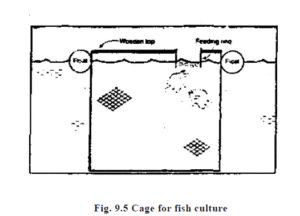
Small cages with mats of locally available plant materials such as palm leaves. Cyperus tronco, Phragmites stem and split bamboo are used in India. These cages are of 1 – 2 m2 area. Split bamboos are joined with the help of coir rope or nylon twine. The cages are installed in the water body with bamboo supports at the four comers and the bottom. Materials other than bamboo mats are decayed by the third month and collapsed within a year. Split bamboo cages remain for over a year. Circular cages with thick bamboo stipes tied with nylon twine the durability of over 3 years.
Cages made up of monofilament woven material of 1 – 3 mm mesh size and 0.3 – 1 mm thickness are light and easy to handle, but remain for 6 to 12 months. The exposed part become brittle and gives way. Knotless nylon webbing of 3 – 6 mm mesh size and knotted nylon webbing of 7 -15 mm mesh have been found to be most durable. Cages made of water – proof surface painted light conduit pipe frames with a 10 m2 area are light in weight and have long durability. A battery of cages is enclosed with a bamboo catwalk and the whole structure floated by sealed empty barrels of 200 1. capacity.
The circular cages with conduit pipe structures which can be easily assembled have been designed with nylon webbing in different dimensions. These cages are floated freely on the water surface with the help of 3 – 4 sealed HDPP jerry cans. These arc extremely useful for cage culture. Due to their circular is shape the wave action in minimum. These can be moved from place to place with least water resistance. Due »their circular shape, the rearing space is maximum in side. The aeration and water circulation is better in these cages. Fishes can move in the cages with least obstruction.
Auto-floating, highly durable HDPP pipe frame nylon net cages with 36 m2 area are also used. These are light in weight and not need floats to float on the water surface.
The size of the cages depend on die scale of culture, species cultured, a infraestrutura, financial and management resources. The size varies from 2- 10m3 in India, 100 – 150m3 in Indonesia, 60- 180m3 in Kampuchia. 40 – 625 m3 in Vietnam and 30 m3 in Holland. Large cages are operated in Germany with 42 m diameter and 16, 500 m3 at the water depth of 12 m. These are provided with automatic or water jet pump-feeding, special handling and harvesting accessories.
Cal t ura b eu e peixe e s eu n c era s um d t h ei r sto c parente g
The fishes used for the cage culture should be adaptable to captive culture, fast gro\vng, hardy and disease resistant. The Indian and Chinese carps, tilapia and magur can also be cultured where trash fish is cheaply and abundantly available. In Thailand and Kampuchia the cat fishes, Pangasius species are being cultured in cages successfully. Koi and Singhi are also cultured in India in cages.
Na Índia, the nursery cages are stocked with carp fry at the range of 150-700 fry/in2 in caaes with different materials. In Japan 15.000-62.000 fry/nr2 of grass carp fry are stocked in nursery cages. The common carp stocking density is 150/nr2 in Kampuchia, 133 -417/nv1 in Indonesia and 80 – 360/nr2 in Vietnam. In Thailand Pangasius sutchi, P. larmmdi e P. micronemus fry are stocked at densities of 150-300/ nr2 in cages of size 1-10 m2 area with a depth of 1.5m. .
The number of fish that can be stocked in a cage is variable and depends on the canying capacity of the water area, water quality and rate of circulation, the fish species, the quality and quantity of feed supplied. A safe level may be about 3000 to 6000 fish/ ha. In able – fish rearing cages in India, the fingerlings of carps are stocked at density of 30 – 38no /m2 . The tilapia, Oreochromis mossambicus can be stocked a rate of 100 – 200 m-2. Murrels can be stocked at density of 40-100m2.
Mãe n ag e homens t um d y eu el d
The cage culture can be taken up in two phases – nursery phase and table – fish rearing phase. In nursery phase of cage culture, the spawn or fry are reared to fingerling stage in 2-3 months. Different feeds can be used for culture in nursery cages. Groundnut oil cake, farelo de arroz, egg yolk, soyabean cake, soyamilk and soya flour are used as food for fry in nursery cages. The silkworm pupae are also tried as supplementary food.
The initial size of fish to be stocked in the cages will depend primarily on the length of the growing season and the desired size at harvest. The carp fingerlings for stocking in 16-20 mm mesh cages should be over 10 gr. to expect a final size of over 500 gr. within 6 months. It should be ensured that the fingerlings used for stocking are healthy and disease free. All the fish should be actively moving. It is ideal to stock cages in the cool part of the day.
Na Índia, the growing season is almost year round, except for December – January in northern parts, where the temperature is low during these winter months. Very little natural food such as plankton, insects and various other organisms enter the cages and is available to fish. Contudo, supplementary feeding is essential in the cage culture to get high production. The types of feed used will depend on the species cultured and their prevailing market prices. Murrels, por exemplo, require to be fed with fish, shrimps or other animal matter. Most of the fish cultured are omnivorous and they accept both plant and animal byproducts such as oilcakes, brans, fish meal and silk worm pupae.
Cage fish are generally fed at least once daily throughout the growing period to get better growth. The quantity of feed to be given is important, since under-feeding will reduce growth and production, while over-feeding will waste costly feed and can affect the water quality. A method used to estimate the daily feed to be give in cages is based on the total weight of the fish. The feed is usually expressed on percentage of body weight. In carps, the feeding rate is 4 – 5 % of the body weight per day until they attain approximately 100 gr. And thereafter at 2 – 3 %.
In table-fish rearing phase, involving the high-tech system of saturated stocking and feeding on enriched formulated feeds, the production recorded in common carp is 25 – 35 Kg m° month’1 in foreign countries. The channel catfish, Lactarius punctatus in USA yielded a production of 20 – 35 Kg/nr3. Na África, tilapia yielded 17 Kg/nr3and trout produced 15 Kg/nr3. The food quotient in these cultures varied from 1.3 – 2.1. Na Índia, a production of 1.5 – 2.5 Kg nr:month’1 common carp was achieved with mixed feed of silk worm pupae, ground cake and rice bran. Catla yielded 1.4 - 2.7 Kg nr2 month’1 with groundnut cake and rice bran with the food quotient 5.6. Tilapia produced 1 – 1.6 Kg nr2 month’1 with a mixture of rice bran, groundnut cake and commercial cattle feed and food quotient ranged from 1.8- 2.3 . About 1 Kg nr2 month”’ of murrel and 0.3 – 1.5 Kg nr2 month’1 of catfishes, singhi and Koi are obtained.
Ca g e cu eu tu ré o f pr uma wn s
The freshwater and marine prawns are also cultured in cages. The cages are stocked with wild or hatchery reared post larvae. Commercial scale rearing of post larvae in floating and fixed nursery cages (3.7 X 2.7 X 1.3 m) has been done with considerable success. They are fabricated from fine mesh (0.5 mm) nylon netting, supported by bamboo poles which are driven into the bottom of the water body. The optimal stocking density reported is 30, 000 post larvae/cage (2 .310 m’3). Feed is provided in trays fixed inside the cages. Inicialmente, the post larvae are fed on a paste of finely ground trash fish, later are fed with fresh mussel meat.
Educaçao Fisica n cultu r e
Recent results in the use of cages, pens or enclosures and recirculating water systems suggest some ways of compact intensification of production in aquaculture given the accessory inputs. This practice may provide great possibilities in the future in certain selected and suitable areas.
Aquaculture in open waters through the use of pens or enclosures is also a means of minimising the limiting effect of metabolities and pollutants on cultivated stock. Greater production in very limited space has been found possible under those situations. Production figures from these types of aquaculture environments approximates to 4 -10 t/ha/yr in Laguna lake in Philippines.
Se eu ectio n o f s ite s para r educaçao Fisica n cultu ré
i) Low tidal amplitude
ii) Fish pen – site must be sheltered as much as possible against high winds
iii) Depth not less than 1 meter during lowest water level
iv) The best site is on the leeward side of the prevailing winds with moderate flow of current especially in a place where current in overturning
v) Water with stable PH slight variation is best. Avoid turbid and polluted water.
vi) Muddy clay and clay – loam soils are best types of bottom soil. Too much still and decomposing organic matter must be avoided.
C ons t ruc t io n o f p en s
Pens can be constructed with the help of bamboo screens and nets
uma . Co n stru c tio n o f p e n s C eu t h b uma mbo o guincho e n s
Split bamboo should not necessarily be shaped and rounded. They are soaked in water for two weeks and then dried for one week. During the soaking and drying period, bamboo poles are prepared and staked at the chosen site according to thedesired size and shape of the fish pen. After stacking poles, bamboo splits are closely woven extending to a length of more or less five meters and made into a roll. After weaving, these are set by stretching them from one pole to the other interrurned or just set inside or outside close to the poles from bottom to top. They are tied every pole by rubber and one provided with sliced rubber around, liming one on top and one at the bottom. These splitted rubber prevent them from wear due to wave action. Nursery nets which should be 1/16 th to 1/10 th of the area of the fish pen can be set before constructing the fish pen or after it is set.
b C sobre s tr você cti o n o f p e n com t h n et s
Construction of a fish pen made out of synthetic netting is easier than one made of bamboo screens. Netting materials can be kuralon, nylon, cremona, tamsi. etc. An ordinary fisherman can connect the nets into the fish.pen after taking into account the desired height or depth of the pen site. After the net is constructed , the poles are staked in mud after making a provision for the front rope and tie rope at the interval of 1.0 – 2.0 m per stake and also the provision for float rope. In preparing the poles, all nodes are cleaned except one node with brunch protending one inch which is staked in the mud from 15 – 30 cm or more depending upon the depth of soft mud. With this node the foot rope is tied, and these together with the bottom net are staked in the mud. Boulders can be used as sinkers in the absence of lead sinkers. Bamboo tips of 1-1 Vi m are also used to stake the bottom net with a foot rope firm into the mud to avoid escape of the fish stock. Construction of the nursery net may be done before or after the construction of the fish pen. They should have a free board of about 1 meter above the normal water level to prevent entry or exit of fishes by jumping and as a precaution against water level fluctuations. Metal and metal coated with HDPP screens are often used for pens which is highly durable.
Cu eu tu ré
Pen culture is extensively practiced in Japan, Peru and Philippines. Fish formers in Laguna debay and Sansabo Kekes stock milk fish fingerlings in pens and grow them to marketable size (200 g or above). Prawn are also similarly cultured. Very little work has been done on pen culture of fishes in India.
Traditional trapping and extensive culture of tiger prawn, milk fish, mancha de pérola, salmonete, bekti and thread fins are done in some sort of pens and enclosures in canals joining the backwaters in Kerala and in the shallow areas of Chilka lake (Janos) in Orissa. The pens are made by weaving split bamboo or with netting. The enclosing of fishes is done usually after the monsoon season upto late autumn and the culture period lasts for about 6 to 8 months. The size of Janos in the Chilka lake varies from 5 to 500 ha. Since the stocking and harvesting are not done systematically, precise production S3* figures areajatavailable. The yield, Contudo, is estimated to be about 60 Kg/ha/season.Seed rearing experiments were conducted in a split bamboo enclosure of 247.5 m2 reinforced with a nylon netting in Punarswamy Bhavanisagar (Tamilnadu). It was stocked with mrigal (size 7 mm) and Labeo fimbratus (size 5 mm) spawn at the rate of 4.6 million/ha and usual farm practices were followed. In 30 days mrigal attained a size of 38 mm and fimbriatus, 28 mm. At the time of conclusion of the study after 3 months, the former had attained a size of 88 mm and the later 75 mm. The overall survival obtained was 27.8 %.
Major carp seed rearing in pens is being done every year from 1982 onwards in the Tungabhadra reservoir in Karnataka. A shallow bay of the reservoir near Hampusagara is cordoned off with bamboo mats reinforced with Casuarina poles and lined with mononlament cloth during the summer months, prior to the reservoir getting filled. The pen is divided into several compartments with bamboo mats, lined with mononlament cloth. When the nursery pen, get water with the filling of reservoir, they are stocked with spawn of carps. The stocking density varies from 5 to 20 million spawn ha. The feed given is a mixture of ground nut cake and rice bran (1 :1). After 2 to 4 months the fingerlings
are enumerated and released in the reservoir. UMA sobrevivência varying from 11 to 30 % is obtained from the varies nursery pens.
A pen culture experiment for raising cattle and rohu in Mamkamaun a flood plain lake in Gandak basic yields a computed production of 4/ ha/6 months. The experiment was conducted in a bamboo screen pen (1000m) and the stock was fed with a mixture of nee bran and mustard cake, apart from a feed formulated from the aquatic weeds collected from the lake. Since intrusion of fishes from outside including predators is possible in pens. It is important to stock larger fingerlings (over 50 g size) to ensure better survival. It is be desirable to have scale pen culture. The species mix and stocking rates will mainly depend on the natural food supply, supplemental feeding strategy, water depth and the duration of rearing.
E aí p lem e nta r y f e edi n g
The fish pens that are densely stocked with 10-20 fish per square meter, generally need regular feeding at the rate of 4 -10 % of the total body weight of the stock at least once 3 week, or it could be divided into daily feeding. The amount of food to be given depends on the condition of the culture fish which could be checked through sampling at least once a month.
Managemen t
Management offish pens is more laborious and demanding than a fish farm, because there are more risks in managing fish pens. Fingerlings are liable to escape once a single bamboo split breaks or a small portion of the net is torn. Every now and then the fish pens have to be checked for any holes or breaks.
The fish pen site has to be laid idle at least one month a year so that excess food and other organic matter are completely decomposed before stocking with new fingerlings. If the site is not sheltered it would be advisable to remove the net or split bamboo screen during the stormy season and repeat during fine weather condition.
S hum m ar y
The culturable species of air breathing fishes are Fig. 9.1
C h uma nn uma s t r uma isto você s – Big or striped murrel or snake head fish
C hann uma punctatu s – Spotted murrel
Channa marulius – Giant murrel
Clarias batrachus – Magur
Heteropneustes fossilis – Singhi
Anabas testudineus – Koi or climbing perch.
Many species of trout are grown, but the three most common of them are the rainbow trout, Slamo gairdneri ou Oncorynchus mykiss, the Eurorean brown trout, S.trutta (Fig. 9.2)and the brook trout, Salvelinus fontinalis. Trouts have a streamlined body, narrow gill openings and reduced gills. Trouts are adapted to highly oxygenated waters and freezing point temperatures. Trouts have great power of locomotion with clinging and burrowing habits. Mouth is modified with rasping lips for food collection from pebbles, rochas, etc..
Sewage is a cloudy, dirty and odorous fluid from our toilets and kitchens of our houses. It has minerals and organic nutrients in a dissolved state or dispersed in a solid condition. Disposal of sewage has become a global problem because of urbanization. It is an effect of demophora, i.e. an unabated growth of human population. Nos últimos anos, sewage has become a major pollutant of inland waters, especially rivers. It is a source of many epidemics. It is responsible for a serious threat to soil and water ecosystems. The approach towards waste water disposal should be utilization of this residue with the concept of their reuse or recycle through an ecologically balanced system involving mainly aquaculture. The utility of sewage effluent to enhance fertility of freshwater ponds has long been known in many countries of the world.
No nosso país, especially in rural areas, mere has been a tremendous growth of biogas plants as a source of non-conventional energy. Biogas is also called as gober gas. The biogas plant is a device for conversion of fermentable organic matter, especially cattle dung into combustible gas and fully matured organic manure or slurry by anaerobic fermentation. The nutrients of the generated slurry can be harvested for production of feed and food and replace conventional inorganic fertilizers. Biogas slurry enhances fish production.










